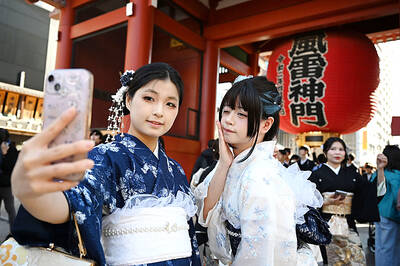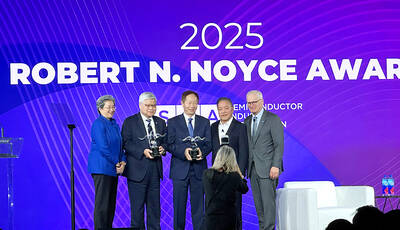As children scoured the huge Toys 'R` Us in Times Square on Friday night, the new Chicken Dance Elmo was dancing his jig and Barbie Rapunzel was busily growing (and retracting) her blond hair. Boxes of Play-Doh were being scooped up, and a group of toddlers stood mesmerized before a room-size Monopoly board.
The good news was that the toys had a certain timeless quality. The bad news was that they all seemed oh so familiar.

PHOTO: NY TIMES
For toymakers approaching Christmas, this is not a big year for originality. Like moviemakers releasing yet another clone of Batman or Men in Black, toy manufacturers this holiday are relying mainly on sequels, best-selling blasts from the past. Besides introducing another Barbie, retuning the Bratz dolls -- plastic teenagers with enormous pouty lips and hip-hugger jeans -- and presenting the latest Harry Potter tie-ins, toy companies are reaching back even further, playing it safe with Care Bears redux and "the new Barney." Even GI Joe is back.
Toymakers concede that this year, there is no first-time Cabbage Patch or Beanie Baby or Razor Scooter. "After all, your basic 6-year-old doesn't remember GI Joe," one toy company executive said.
"I agree that there isn't a Teletubby this year," said Neil Friedman, president of Fisher-Price toys, referring to the character based on the popular television series. Mattel, which owns Fisher-Price, brings 400 new toys to market every year, he said. Nevertheless, a spokesman for Mattel said the company's first priority was to build on the foundations of the past.
"Mega-hits are unpredictable," explained another toy executive. "They burn hot."
This year, the experts say, the toy companies are even more cautious than usual. "In an uncertain year, extending the brand is a safety net; if you're selling US$1.8 billion a year, you don't want to throw away the mold and start something new," explained Jim Silver, the co-publisher of the trade magazine Toy Wishes, referring to the big toy manufacturers. "You want to extend the brand."
Especially when the cost of developing, manufacturing and advertising a new toy is so high. Silver estimates the cost of a new Barbie at perhaps US$1 million, including "the new packaging, the new hair, the new clothes and the new advertising." But for a totally new doll, the cost might be "7, 8, 10 million." The price of a new radio-controlled toy? Twenty or 30 times the cost of recycling, Silver said.
Even with a host of familiar names on the shelves, analysts are having a tough time trying to gauge the health of this year's holiday toy-buying season. But no one is anticipating a stellar holiday. Sean McGowan, a managing director at Gerard Klauer Mattison, predicted the toy-selling season would be flat. Silver estimates sales may be up at best a percent or two from last year. Britt Beemer, chairman of America's Research, estimates that Christmas toy sales will be flat to down 2 percent.
But children are notoriously fickle, and analysts and toymakers alike hold out hope -- despite their predictions -- for a monster hit to energize the US$29 billion a year business.
"Don't forget, Tickle Me Elmo wasn't even introduced until after Thanksgiving," said McGowan.
The hottest toys he sees on the horizon are the Hobbico MicroSizers, 5cm minicars operated by radio control and made by Tomy. The cars sell for US$20 to US$30.
"I guess you could say they're retreads, too," he said. "But they've never had remote-controlled cars so small."
Of the other sequels, Chicken Dance Elmo seems the most promising. When you touch the toy's big toe, it squawks: "C'mon, everybody, let's do the Chicken Dance."
Chicken Dance Elmo has one demographic going for it that the early Elmos did not have. "What's surprising is the number we're selling to teenagers and people in their 20s," he said.
Silver estimated that the stores will sell 1.3 million to 1.4 million Chicken Dancers by the end of the Thanksgiving weekend. "Chicken Dance Elmo is blowing out," he said. Silver has also heard from stores that twice as many Barbie Rapunzels have sold this year, versus the sales of Barbie Nutcrackers by the same time last year. But that may not be saying much.
"Last year between Sept. 15 and Nov. 1 there weren't any toy sales at all -- nobody was shopping," he said.
Video-game sales this year have been disappointing, he said, along with sales of the Crayola Crayon Maker, which Silver had predicted a month ago was going to be spectacular. The more-expensive radio-controlled category -- cars and trucks costing over US$60 -- has also been slow; the RC Helicopter, a possible winner, has had delays getting to the shelves.
Friedman of Fisher-Price said that while the Spider-Man toys based on the movie started out "red hot," toys based on movie properties tended to slow down quickly. "Toys based on television last the longest," he said, because the preschoolers and other children watch them "over and over again."

Shiina Ito has had fewer Chinese customers at her Tokyo jewelry shop since Beijing issued a travel warning in the wake of a diplomatic spat, but she said she was not concerned. A souring of Tokyo-Beijing relations this month, following remarks by Japanese Prime Minister Sanae Takaichi about Taiwan, has fueled concerns about the impact on the ritzy boutiques, noodle joints and hotels where holidaymakers spend their cash. However, businesses in Tokyo largely shrugged off any anxiety. “Since there are fewer Chinese customers, it’s become a bit easier for Japanese shoppers to visit, so our sales haven’t really dropped,” Ito

The number of Taiwanese working in the US rose to a record high of 137,000 last year, driven largely by Taiwan Semiconductor Manufacturing Co’s (TSMC, 台積電) rapid overseas expansion, according to government data released yesterday. A total of 666,000 Taiwanese nationals were employed abroad last year, an increase of 45,000 from 2023 and the highest level since the COVID-19 pandemic, data from the Directorate-General of Budget, Accounting and Statistics (DGBAS) showed. Overseas employment had steadily increased between 2009 and 2019, peaking at 739,000, before plunging to 319,000 in 2021 amid US-China trade tensions, global supply chain shifts, reshoring by Taiwanese companies and

Taiwan Semiconductor Manufacturing Co (TSMC, 台積電) received about NT$147 billion (US$4.71 billion) in subsidies from the US, Japanese, German and Chinese governments over the past two years for its global expansion. Financial data compiled by the world’s largest contract chipmaker showed the company secured NT$4.77 billion in subsidies from the governments in the third quarter, bringing the total for the first three quarters of the year to about NT$71.9 billion. Along with the NT$75.16 billion in financial aid TSMC received last year, the chipmaker obtained NT$147 billion in subsidies in almost two years, the data showed. The subsidies received by its subsidiaries —

Taiwan Semiconductor Manufacturing Co (TSMC) Chairman C.C. Wei (魏哲家) and the company’s former chairman, Mark Liu (劉德音), both received the Robert N. Noyce Award -- the semiconductor industry’s highest honor -- in San Jose, California, on Thursday (local time). Speaking at the award event, Liu, who retired last year, expressed gratitude to his wife, his dissertation advisor at the University of California, Berkeley, his supervisors at AT&T Bell Laboratories -- where he worked on optical fiber communication systems before joining TSMC, TSMC partners, and industry colleagues. Liu said that working alongside TSMC